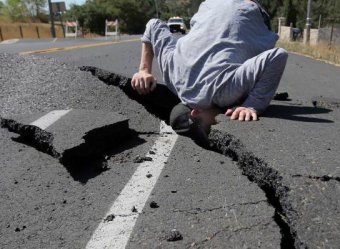On the night of September 5, 2018, an earthquake with a magnitude of 5.5 occurred in the South of the Ural Mountains in Russia.
There were no casualties. Nevertheless, more than ten public facilities were damaged. Among them were kindergartens, regular schools, as well as an industrial technical school.
The power of 5,5 points earthquake is pretty disturbing. Earthquakes of such magnitude are not expected to occur in the Urals.
Vsevolod Anfilogov, Doctor of Geological and Mineralogical Science and Corresponding Member of the Russian Academy of Sciences, commented:
“Seismic activity is not typical for the Ural mountains because the mountains are old. The South Urals has always been a calm territory, but the earth’s crust at this location is very elastic, so an earthquake may well occur.”
Nevertheless some commentators view this earthquake as one of the events in the long chain of other natural catastrophes of recent times.
In 2017, Russia recorded 907 dangerous natural phenomena, with 378 of them causing significant damage in the sphere of economy and vital activities of the population. According to the Ministry of Emergencies, 42 natural disasters occurred in the country, about 34,000 people were injured, and 33 died. The number of victims had increased eleven fold as compared to 2016.
The Ministry of Natural Resources made a forecast of the expected changes in the lives of Russians due to the global climate change. The country is expecting tornadoes, floods, epidemics, crop failure, infrastructure destruction and other ills. This was reported by the popular newspaper Kommersant (https://www.kommersant.ru/doc/3732772) with reference to the annual report of the Ministry of Natural Resources “On Environmental Protection”.
The article is entitled: “Hunger, death and deformation of railways – the Ministry of Natural Resources wrote a scenario of climatic apocalypse”.
The ministry’s report notes that warming in the Russian Federation is proceeding more rapidly than on the whole plane. In particular, from 1976 to 2017, the average annual temperatures grew by 0.45 degrees centigrade (in the World – by 0.18 C degrees). Last year was recognized in Russia as the fourth among the warmest in the country since 1936.
The forecast of “possible expected damage” from climate change in the Russian Federation identifies ten specific climatic threats and identifies regions that are most vulnerable to them. For example, in the south of Russia and in the southern part of Siberia, droughts caused by the reduction of the volume of rivers may affect the water availability for the population, infrastructure, and agriculture. Because of the likely rise of the level of the Caspian sea, the coastal areas will be in the zone of flooding, and the melting of the permafrost in the tundra must cause “the destruction of places of disposal of hazardous chemical, biological and radioactive substances.”
Changes in humidity and temperatures threaten “accelerated aging of buildings and roads, especially in the European part of Russia, in southern Siberia and Far East. In the southern regions of the country, an increase in the number of accidents is possible” due to the deformation of railway tracks at extremely high air temperatures. The Ministry of Natural Resources believes that in the central and southern areas, because of the heat, mortality may increase, especially among the elderly and people suffering from cardiovascular diseases. The incidence of various infections is also likely to increase.
Warming, it is noted in the document, will cause the expansion of habitats of pests. This, in turn, will lead to the destruction of forests in the north of the European part of Russia, the south of Eastern Siberia, and the center of Yakutia.
The source assures that the Ministry of Natural Resources intends to become the main developer and coordinator of the climate policy. Therefore, the department emphasized the climate in its report.


